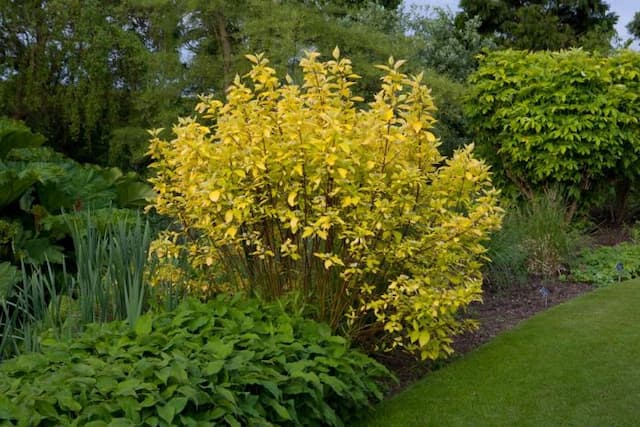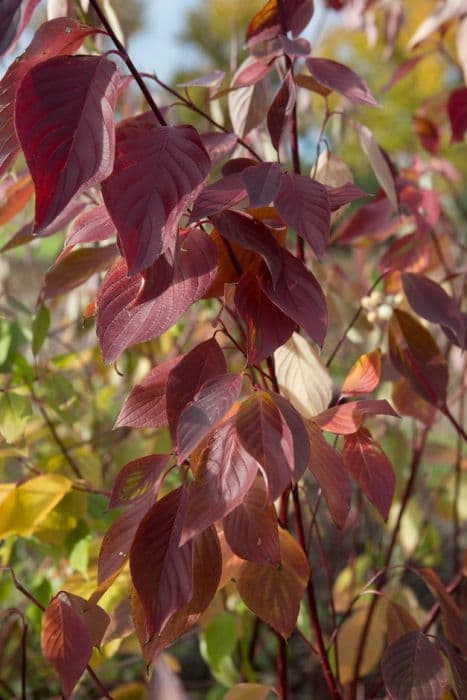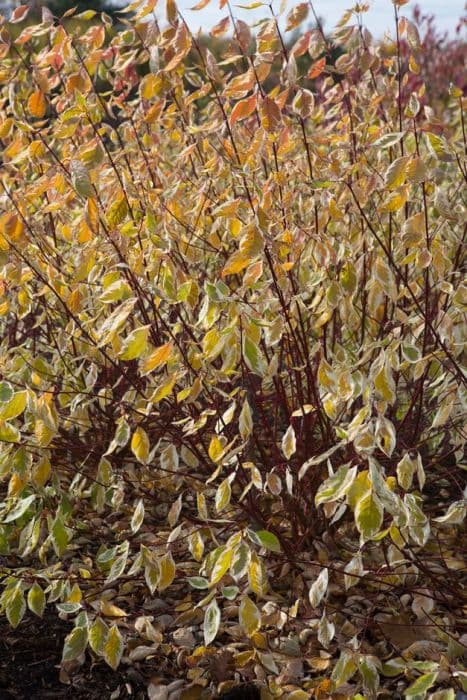Japanese Cornel Cherry Cornus officinalis

ABOUT
Cornus officinalis, commonly known as Japanese cornel or Cornellian cherry, is a deciduous shrub or small tree that boasts a multitude of appealing features throughout the seasons. In late winter to early spring, before the foliage emerges, it comes alive with small yellow flowers that cover the branches, providing a bright and cheery display. These flowers are structured in dense clusters and are particularly attractive against the backdrop of the late winter landscape. As the flowering season concludes, the plant springs forth oval-shaped leaves, which start off with a glossy green color and later develop into purplish-red shades come fall. The leaves are opposite in arrangement and have visible veins that give them a texture, adding depth to their appearance. Following the flowering season, berry-like fruits appear, initially bright red and gradually maturing to a darker, blackish hue as the season progresses. These fruits are small and oval, adding another layer of visual interest and appeal to the plant. The bark of Japanese cornel is rough and exfoliating, with a mix of gray and brown tones that lends the plant a rugged and rustic character. Overall, Japanese cornel is a plant with a kaleidoscope of features that change and evolve throughout the year, providing lasting appeal for any garden or naturalized setting. Its compact form, brilliant flowers, attractive foliage, summer fruits, and textured bark make it a multifaceted addition to the landscape.
About this plant
 Names
NamesSynonyms
Japanese Cornel Dogwood, Japanese Cornelian Cherry, Asian Cornel Dogwood, Asian Cornelian Cherry, Chinese Cornel Dogwood, Chinese Cornelian Cherry.
Common names
Cornus officinalis Siebold & Zucc.
 Toxicity
ToxicityTo humans
Cornus officinalis, commonly known as Japanese cornel or Japanese cornelian cherry, is not widely recognized for having toxic effects on humans. Parts of the plant, like the fruit, have been used in traditional medicine. However, as with any plant, individual allergies or sensitivities might exist, which could cause adverse reactions if ingested. It is always best to exercise caution and consult with a healthcare professional before consuming any part of a plant not typically recognized as food. There is no widespread documentation on the toxicity of this plant leading to poisoning in humans.
To pets
Japanese cornel is not commonly listed as a toxic plant to pets. However, the specific reaction of pets, especially dogs and cats, to this plant may not be well-documented, and individual animals might have different sensitivities or allergies to this plant. As with any non-food plant, it is prudent to prevent pets from ingesting it as a precaution. If your pet does consume any part of the Japanese cornelian cherry and you observe any signs of illness, contact your veterinarian. Signs that a pet may have eaten something toxic typically include vomiting, diarrhea, lethargy, or unusual behavior.
 Characteristics
CharacteristicsLife cycle
Perennials
Foliage type
Deciduous
Color of leaves
Green
Flower color
Yellow
Height
15-25 feet (4.6-7.6 meters)
Spread
15-20 feet (4.6-6.1 meters)
Plant type
Shrub
Hardiness zones
5
Native area
Asia
Benefits
 General Benefits
General Benefits- Landscape aesthetic – Cornus officinalis, commonly known as Japanese cornel or cornelian cherry, provides ornamental value with its bright yellow flowers that bloom in early spring before the foliage emerges, adding color and vibrancy to gardens.
- Wildlife support – It produces edible red berries that are attractive to birds and other wildlife, serving as a source of food and promoting biodiversity in the area.
- Erosion control – With its extensive root system, this plant can help stabilize soil and prevent erosion on slopes and in areas prone to soil displacement.
- Shade and cooling – The tree can offer shade in landscaped areas, which could contribute to local cooling and provide relief from the sun during the hotter months.
- Windbreak – When planted in rows or groups, Cornus officinalis can act as a windbreak, protecting areas from strong winds and helping to reduce wind-related erosion.
 Medical Properties
Medical Properties- Anti-inflammatory: Cornus officinalis may have properties that help reduce inflammation.
- Antioxidant: The plant contains compounds that have the potential to counteract oxidative stress.
- Hepatoprotective: It might offer protection to the liver from certain forms of damage.
- Antimicrobial: Some studies indicate potential antimicrobial activity against various pathogens.
- Antipyretic: Traditionally used to help reduce fever.
- Diuretic: Can promote the production of urine, aiding in the flushing of toxins from the body.
 Air-purifying Qualities
Air-purifying QualitiesThis plant is not specifically known for air purifying qualities.
 Other Uses
Other Uses- The fruit of Cornus officinalis, commonly known as Japanese Cornel, can be used to make a traditional Korean vinegar called Sansuyu which is often used in cooking for its unique flavor.
- Wood from the Japanese Cornel tree is dense and can be used to make high-quality woodworking tools such as mallets and plane bodies due to its fine grain and durability.
- The bark of the Japanese Cornel tree can be used in the tanning process as it contains tannins that help cure leather.
- Dye can be extracted from the bark and fruit of the Japanese Cornel to produce colors ranging from yellows to olive greens for textiles and crafts.
- The flowers of the Japanese Cornel are used in floral arrangements in Japan, especially during the New Year, symbolizing longevity and endurance.
- Jams and preserves can be created from the fruit, providing a unique taste aside from its traditional medicinal applications.
- In traditional East Asian gardens, Cornus officinalis is planted for its ornamental value, especially during the late winter and early spring when its bright yellow flowers bloom.
- The tree's wood being resistant to splitting and shrinking, is utilized in crafting handles for tools and sports equipment, providing a sturdy grip.
- Fruit of the Japanese Cornel can be fermented to produce a country wine with a distinctive tangy taste.
- In bonsai, the Japanese Cornel is sometimes used as a specimen due to its attractive flowers and fruit as well as its bark texture.
Interesting Facts
 Feng Shui
Feng ShuiThe Japanese Cornel is not used in Feng Shui practice.
 Zodiac Sign Compitability
Zodiac Sign CompitabilityThe Japanese Cornel is not used in astrology practice.
 Plant Symbolism
Plant Symbolism- Longevity and Durability: Cornus officinalis, commonly known as Japanese cornel, is associated with longevity and durability because it is a hardy plant that can withstand a variety of conditions and survives for many years.
- Protection: The hard outer wood of the Japanese cornel has been used to make tools and weapons, leading to its symbolic association with strength and protection.
- Renewal and Resilience: As an early bloomer that often signals the end of winter, the Japanese cornel represents renewal and the resilience of life to return after hardship.
- Wealth and Abundance: Because the fruit of the Japanese cornel is both abundant and used in traditional medicine, it symbolizes wealth, both in terms of material riches and health.
 Water
WaterThe Japanese Cornel, or Cornus officinalis, requires regular watering to maintain moist but not waterlogged soil. During the growing season, it is recommended to water the plant deeply once a week, providing about 1.5 gallons for medium-sized shrubs. Adjust the frequency of watering during periods of extreme heat or drought, possibly increasing to twice per week. In winter, reduce watering to match the plant’s reduced requirements due to dormancy. Always check the first couple of inches of soil for dryness before watering to avoid overwatering.
 Light
LightThe Japanese Cornel thrives best in full sun to partial shade. Planting it in a location that receives at least 4 to 6 hours of direct sunlight daily is ideal to promote healthy growth and flowering. However, it can also tolerate some shade, especially in hotter climates where afternoon shade can help protect the plant from excessive heat.
 Temperature
TemperatureThe Japanese Cornel is hardy and can survive in temperatures ranging from 5 to 90 degrees Fahrenheit. The ideal growing temperature for optimal health and flowering is between 60 and 75 degrees Fahrenheit. Avoid placing the plant in areas where winter temperatures drop below 5 degrees Fahrenheit, as extreme cold can damage the plant.
 Pruning
PruningPruning the Japanese Cornel is mainly done to maintain its shape and remove any dead or diseased wood, enhancing the plant's health and appearance. Prune in late winter or early spring before the new growth starts. Thin out overcrowded branches and cut back any that are crossing or rubbing against each other. This should be done annually or as needed to keep the shrub well-groomed.
 Cleaning
CleaningAs needed
 Soil
SoilCornelian cherry (Cornus officinalis) thrives best in well-draining soil with a pH range of 5.5 to 7.5. A balanced mix of loamy soil, peat, and sand or perlite would provide the necessary drainage and nutrients. It is important to ensure the mix does not retain excess water, which can lead to root rot.
 Repotting
RepottingCornelian cherry plants typically do not need to be repotted frequently. Younger plants can be repotted every two to three years, while mature plants can go longer without repotting unless they show signs of being root-bound or the soil has degraded.
 Humidity & Misting
Humidity & MistingThe cornelian cherry prefers moderate humidity levels, around 40-60%. It can tolerate some level of dryness, but consistent humidity close to the ideal range will assist in optimal growth and health of the plant.
 Suitable locations
Suitable locationsIndoor
Provide bright light, keep soil moist, and ensure good air flow.
Outdoor
Plant in well-draining soil, full sun to partial shade.
Hardiness zone
5-8 USDA
 Life cycle
Life cycleCornus officinalis, commonly known as Japanese cornelian cherry, begins its life cycle as a seed which needs to undergo a period of cold stratification to break dormancy. Upon germination in early spring, the seedling emerges and establishes a root system while producing its first leaves. The plant then enters a vegetative growth phase where it grows steadily, developing a woody stem and branches. After a few years of growth, it reaches maturity and starts producing small yellow flowers in late winter to early spring before the leaves emerge. Following pollination, usually by bees, it sets fruit which is a bright red drupe that matures by late summer to autumn. The plant continues to grow and reproduce annually, with some specimens capable of living for decades under optimal conditions.
 Propogation
PropogationPropogation time
Spring through Summer
For the Cornus officinalis, commonly known as Japanese cornel or cornelian cherry, the most popular method of propagation is through seed. Propagation time typically begins in autumn after the fruit has ripened. To propagate by seed, one should first extract the seeds from the ripe berries, then clean and dry them. Stratification is often required, which involves chilling the seeds for a period of 90-120 days in moist sand or peat at a temperature of 33-41 degrees Fahrenheit (0.5-5 degrees Celsius), to break the seed dormancy. After stratification, seeds should be sown in a well-draining soil mix at a depth of about twice the diameter of the seed. Germination can be slow and irregular. Once seedlings emerge and reach a suitable size, they can be potted on or planted out into their final location.

![Dogwood [Baton Rouge]](/_next/image?url=https%3A%2F%2Fplants-admin.emdemapps.com%2Fimages%2Fplants%2F%2Fimages%2F604b59cf0fefd.png&w=640&q=75)


![Dogwood [Ivory Halo]](/_next/image?url=https%3A%2F%2Fplants-admin.emdemapps.com%2Fimages%2Fplants%2F%2Fimages%2F604b535cbcb9a.png&w=640&q=75)




